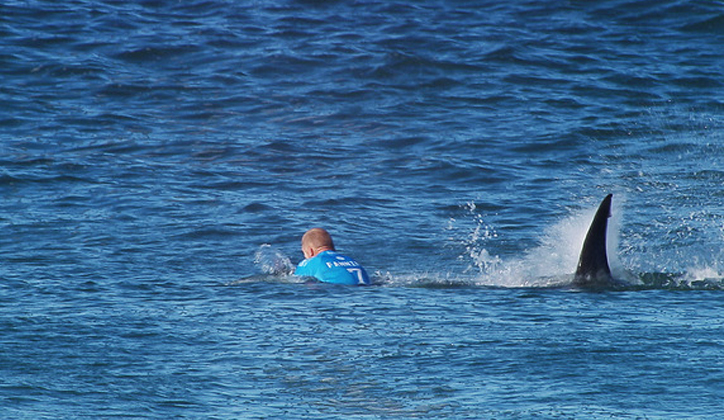This article was originally published by Nathan Hart on The Conversation, and shared as part of the Creative Commons.
Australian surfer Mick Fanning’s decision to abandon a yellow surfboard in favour of one with more black and blue colouring has raised the question of how sharks perceive colour.
His decision, ahead of the start of the Billabong Pro surfing competition in Tahiti, follows his recent encounter with a shark while surfing at Jeffreys Bay in South Africa.
Given the number of people that swim, surf, paddle and dive in the ocean all year round, such incidents are fortunately very rare. But the reasons why sharks interact with – and sometimes attack – humans are unclear, which makes prevention of such incidents a challenge.
Sharks possess an impressive array of senses, including an acute sense of smell, hearing based on internal ears as well as a lateral line sensitive to low frequency water vibrations, and even the ability to detect the tiny electric fields generated by other living organisms.
But vision is likely to be the critical sense in the moments immediately prior to an attack, especially for fast moving pelagic sharks such as the great white shark.
Experimenting with colour
In the 1960s and 1970s, the United States Office of Naval Research funded a large program of research into shark sensory biology with the goal of finding effective shark deterrent strategies for service personnel that found themselves adrift in the ocean.
One of the findings of this research was that the colour of an object floating in the water had a strong influence on the likelihood that a shark would approach and interact with it. Highly reflective silvery and white objects were more likely to attract bull sharks and tiger sharks than blue or black objects.
A subsequent study looked at life vests and infant flotation devices (IFD) of the kind used by commercial airlines and found that blue sharks and mako sharks readily attacked child dummies dressed in the standard bright yellow life vests, but tended to ignore dummies dressed in black life vests or housed within a black IFD.
These findings gave rise to the saying “yum yum yellow” and created a survival conundrum: high contrast colours that would better enable a person adrift in the water to be spotted by rescuers were also more likely to provoke a shark attack.
Recent research suggests that most or all sharks are completely colour-blind. They lack the basic neural machinery in the retina that is required to compare objects on the basis of their spectral reflectance (i.e. colour vision) and instead can only make discriminations based on brightness differences.
Shades of grey
Thus, sharks see the underwater world in shades of grey and, rather than being attracted to a particular colour, they are probably attracted to what humans think of as yellow simply because it is a bright object against the darker background of the water.
Whether or not Mick Fanning’s decision to swap his yellow board for a blue or black one will actually reduce his risk of shark attack is unclear.
The lower absolute reflectance (and thus brightness contrast) of a darker-coloured board may well be less attractive to a shark approaching from the side, but a shark approaching directly from below will see the surfboard as a dark silhouette against the sky regardless of the colour of the board.
Moreover, some highly visible, high contrast patterns may in fact act as useful warning signals that might deter sharks. For example, there are reports in the literature that some (but not all) species of shark tend to avoid venomous black and white-banded sea snakes.
Watersports apparel that exploits these contrasting visual deterrent strategies—conspicuousness versus camouflage—are currently available. For example, there are camouflage wetsuits for SCUBA divers that may help to make the wearer appear less visible or less attractive to a curious shark.
Vision-based shark deterrent options for surfers are perhaps more limited because of the difficulty in camouflaging a surface object against the bright sky. But we are currently researching options for surfboard camouflage that include reducing the contrast of the surfboard’s silhouette by illuminating the underside of the surfboard with bright LED lights, a strategy known as counter-illumination that is employed by many aquatic animals to avoid detection by predators.
For the moment, surfers can wear a well-publicised electronic shark deterrent device that has been shown by us and others to be effective in deterring several different species of sharks.
There are also other simple ways to reduce the risk of a negative interaction with a shark.
- Avoid entering the water at dawn or dusk when many species of shark are hunting more actively, and when the dim light conditions may make it more likely for a shark to mistake a human for its usual prey.
- Avoid swimming or surfing near seal colonies where sharks may wait for an opportunity to ambush seals as they head out to sea.
- Avoid entering the water when there are large schools of baitfish present or where there are natural (e.g. a whale carcass) or artificial (e.g. fish frames) sources of animal waste that might attract sharks.
- Do not enter the water (or leave immediately) if you have a wound that is discharging blood.
- Remember that activities such as spear fishing may carry a significantly higher risk of triggering a shark attack.
Listening to advice from recognised authorities such as the Department of Fisheries and surf lifesavers is paramount. Where possible, swim between the flags where there are more people and better surveillance.
At the end of the day, it is important to remember that shark attacks are still very rare and some simple precautions will ensure continued safe use of the ocean.
Catch up on recent contributions to The Conversation from other Macquarie authors.

